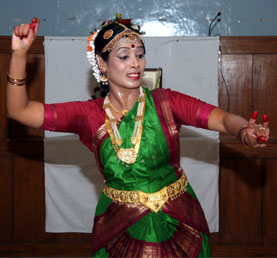Apr 18, 2024
Apr 18, 2024
by V. Soumyasri
 Whenever I begin a new class with new aspirants from different religious backgrounds or choreograph for some special performance, I ponder where to begin. I try and think of songs or themes which are adequate for the situation without any strings attached to a particular faith. It becomes very difficult but somehow I manage to do with some instrumental music.
Whenever I begin a new class with new aspirants from different religious backgrounds or choreograph for some special performance, I ponder where to begin. I try and think of songs or themes which are adequate for the situation without any strings attached to a particular faith. It becomes very difficult but somehow I manage to do with some instrumental music.
These days I am visiting an NGO, they are preparing a small cultural programme to be put up on the United Nations Foundation Day in New Delhi. This NGO helps families below poverty line by giving them useful vocational training and teaching them the benefits of Organic farming. It's a setup in rural area, a part of not so very affluent Maharashtra.
As a dance teacher when I visited the place for the first time, all of them gathered around me. Everybody wanted to see what I was doing or rather teaching and slowly they all wanted to dance. They are in assorted age group of 15 to 65 but the enthusiasm was at par. It was really refreshing and encouraging for me and the interaction with them is something unforgettable.
I was wondering where to begin, these women coming from various backgrounds socially and culturally with very little education to boot. But the first few minutes gave me fair idea; the abundance of desire in them will definitely make up for the skill. The women have come from diverse religious, cultural and linguistic backgrounds.
I usually begin my dance class with couple of body stretching, breathing and yoga exercises, they were trying to repeat all in their sarees though it was cumbersome, they did not complain. I was trying to correct everybody's posture, my urbane upbringing made me even say that they must take care of their body, here I must mention they were all slim and almost in shape though rather stiff and clumsy in posture but the age old cultural baggage made them hesitate to sit straight and erect.
It was not the shyness but was an automatic reaction which is ingrained somewhere deep in the physic. Now as a classical dance teacher trained in Bharata Natyam, I began with Namaskar, demonstrated for them a few times. Everyone tried to repeat in their own way, certainly they were doing for the first time trying to correct the leg positions, hand movements etc., they wee around 25, and each one needed my assistance.
I saw one woman (must I say a girl because they marry so young) standing in the corner not even trying to do anything. I ignored it thinking that she must be having some problem.
I continued performing the same Namaskar over the next twenty minutes, I forgot about the girl. Only one or twice I happened to notice that she was intently looking at the other 'dancers'. Practice session was over; six to seven of them almost learnt how to perform Namaskar. I was also thrilled at my achievement.
While I was leaving the hall an elderly lady came to me, right from the beginning I thought she was some kind of a leader, she was polite and confident. I was wondering what she wanted to ask me. But what she asked me was really startling.
This is what she asked, 'Madam, Shabnam also wants to dance but she wants to ask her husband first', Unaware of what the elderly lady meant I just said 'fine'.
But the lady persisted, 'Madam, Shabnam is worried, it is Hindu dance no? It is like Puja no? Shabnam is not Hindu, how will she be able to convince her husband?'
It was a very difficult situation for me, how can we convince Shabnam's husband,
Right from the first step which I was teaching them, Shabnam's husband might find it very famous. And it not only Shabnam, there may be millions and millions of Shabnams.
In the world when we are talking about globalization are we going to remain as conservative and orthodox as we are today, in the name of classicism do we have any right to deprive Shabnam, Suzanne or anyone else whose faith does not match for certain scriptures, and what they follow as a religious sanctity will deprive them from learning this great art form of Indian Classical dance which is deeply rooted in Hindu culture.
The motifs, symbols, gestures, myths, regions, epics used in performances are predominantly borrowed from Hindu culture.
All these thoughts confused me further and I am trying to find convincing answer for Shabnam's husband and I know for sure Shabnam wants to dance and I hope the day will come soon.
Recently I read in The Times of India's Sunday section of Q & A with Navtej Johar, the one of the few accomplished male Bharata Natyam dancer's view and I was heartened to know that he feels that somewhere the saturation point has come in some Indian classical dance forms and we need to revive it again and he is experimenting with unconventional and innovative ideas.
Many dancers like Late Chandralekha, Dr. Kanak Rele, Anita Ratnam and many dancers/scholars have worked and are working hard on these lines to make it secular and global. I am not losing hope and I think I am getting inspired to give it a serious thought to this and have some convincing answer for Shabnam's husband.
I wonder when this classical art form will truly be global where no Shabnam or Suzanne will be deprived of learning.
16-Dec-2007
More by : V. Soumyasri